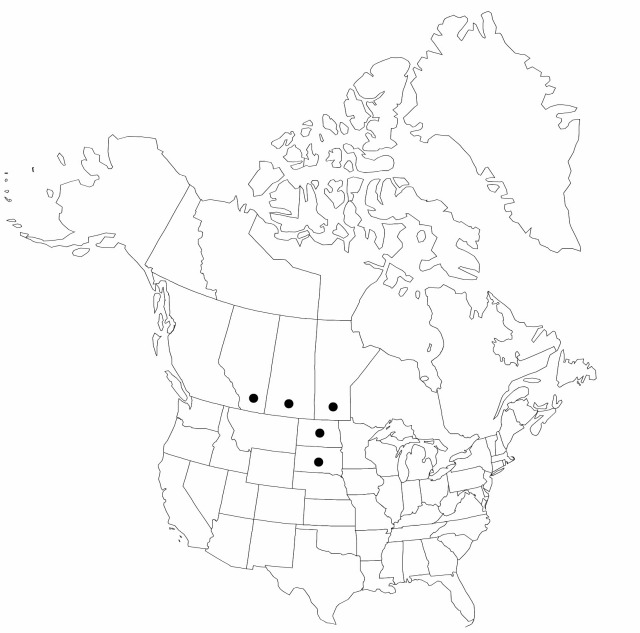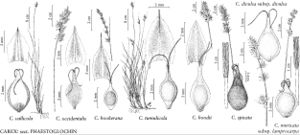Difference between revisions of "Carex hookeriana"
Amer. J. Sci. Arts 29: 248, plate X, fig. 75. 1836.
RevisionBot (talk | contribs) m (Bot: Adding category Revised Since Print) |
imported>Volume Importer |
||
| Line 6: | Line 6: | ||
|place=29: 248, plate X, fig. 75. 1836 | |place=29: 248, plate X, fig. 75. 1836 | ||
|year=1836 | |year=1836 | ||
| + | }} | ||
| + | |special_status={{Treatment/ID/Special_status | ||
| + | |code=F | ||
| + | |label=Illustrated | ||
| + | }}{{Treatment/ID/Special_status | ||
| + | |code=E | ||
| + | |label=Endemic | ||
}} | }} | ||
|basionyms= | |basionyms= | ||
| Line 23: | Line 30: | ||
|elevation=300–500 m | |elevation=300–500 m | ||
|distribution=Alta.;Man.;Ont.;Sask.;N.Dak.;S.Dak. | |distribution=Alta.;Man.;Ont.;Sask.;N.Dak.;S.Dak. | ||
| − | |discussion=<p><i>Carex</i> | + | |discussion=<p><i>Carex hookeriana</i> was collected once in Ontario along Lake Superior’s north shore, but its status in Ontario is unclear.</p> |
|tables= | |tables= | ||
|references= | |references= | ||
| Line 45: | Line 52: | ||
|publication title=Amer. J. Sci. Arts | |publication title=Amer. J. Sci. Arts | ||
|publication year=1836 | |publication year=1836 | ||
| − | |special status= | + | |special status=Illustrated;Endemic |
| − | |source xml=https:// | + | |source xml=https://bibilujan@bitbucket.org/aafc-mbb/fna-data-curation.git/src/bb6b7e3a7de7d3b7888a1ad48c7fd8f5c722d8d6/coarse_grained_fna_xml/V23/V23_495.xml |
|genus=Carex | |genus=Carex | ||
|section=Carex sect. Phaestoglochin | |section=Carex sect. Phaestoglochin | ||
| Line 52: | Line 59: | ||
}}<!-- | }}<!-- | ||
| − | --> | + | -->[[Category:Treatment]][[Category:Carex sect. Phaestoglochin]] |
| − | |||
| − | [[Category:Treatment]] | ||
| − | [[Category:Carex sect. Phaestoglochin | ||
| − | |||
Revision as of 21:34, 27 May 2020
Plants without conspicuous rhizomes. Culms 15–80 cm, 1.5–2 mm wide basally, 0.5 mm wide distally. Leaves: sheaths tight, green, fronts white-hyaline; ligules less than 2 mm, wider than long; widest leaf blades 1.5–2.5 mm wide. Inflorescences with 5–10 spikes, 2–5 cm × 5–10 mm; proximal internodes 1–2 times as long as proximal spikes; proximal bracts 1–2 cm; spikes with 5–10 erect perigynia. Pistillate scales brown with green midvein, ovate, 2.7–3.6 × 1.4–2.1 mm, body longer and wider than perigynium, apex awned. Anthers not measured. Perigynia pale green to pale brown, veinless or obscurely veined abaxially, 2.6–3.5 × 1.2–1.5 mm, margins serrulate distally; beak 0.8–1.5 mm, apical teeth 0.3–0.5 mm. Achenes elliptic-circular, 1.5–1.7 × 1.1–1.2 mm.
Phenology: Fruiting late spring–early summer.
Habitat: Swamps, mesic to wet-mesic grasslands and open forests
Elevation: 300–500 m
Distribution

Alta., Man., Ont., Sask., N.Dak., S.Dak.
Discussion
Carex hookeriana was collected once in Ontario along Lake Superior’s north shore, but its status in Ontario is unclear.
Selected References
None.
